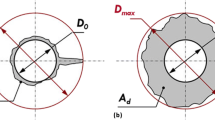Abstract
Glass fiber-reinforced epoxy composites are one of the potential lightweight structural materials used in various engineering applications due to its excellent properties. Drilling is most widely applied for fastening the composite structures; nevertheless, the damage induced by this operation may reduce the component performance drastically. To establish the damage level, delamination is measured quantitatively using digital imaging techniques. In this study, to quantify the delamination severity effectively, a new refined delamination factor (FDR) is proposed and validated using experimental results observed from three-point bend tests (3PT) and modified short beam shear tests. The value of determined refined delamination factor (FDR) is more accurate compared to the calculated conventional (FD) and adjusted (FDA) delamination factors.
Similar content being viewed by others
References
Koenig, W., Wulf, C., Grass, P., and Willerscheid, H., “Machining of Fiber Reinforced Plastics,” Machining of Fiber Reinforced Plastics 34(2):538–548 (1985).
Khashaba, U.A., “Delamination in Drilling GFR-thermoset Composites,” Composite Structures 63(3–4):313–327 (2004).
Davim, J.P., and Pedro R., “Study of Delamination in Drilling Carbon Fiber Reinforced Plastics (CFRP) Using Design Experiments,” Study of Delamination in Drilling Carbon Fiber Reinforced Plastics (CFRP) Using Design Experiments 59:481–487 (2003).
Arul, S., Vijayaraghavan, L., Malhotrab, S.K., and Krishnamurthy, R., “The Effect of Vibratory Drilling on Hole Quality in Polymeric Composites,” The Effect of Vibratory Drilling on Hole Quality in Polymeric Composites 46:252–259 (2006).
Aoyama, E., Nobe, H., and Hirogaki, T., “Drilled Hole Damage of Small Diameter in Printed Wiring Board,” Drilled Hole Damage of Small Diameter in Printed Wiring Board 118:436–441 (2001).
Kao, W.H., “Tribological Prosperities and High Speed Drilling Application of MoS2–Cr,” Tribological Prosperities and High Speed Drilling Application of MoS2–Cr 258:812–825 (2005).
Compos Rubio, J., Abrao, A.M., Faria, P.E., Esteves Correia, A., and Paulo Davim, J., “Effects of High Speed in the Drilling of Glass Fibre Reinforced Plastic: Evaluation of the Delamination Factor,” Effects of High Speed in the Drilling of Glass Fibre Reinforced Plastic: Evaluation of the Delamination Factor 48:715–720 (2008).
Hocheng, H., and Puw, H.Y., “On Drilling Characteristics of Fiber-Reinforced Thermoset and Thermoplastics,” On Drilling Characteristics of Fiber-Reinforced Thermoset and Thermoplastics 32(4):583–592 (1992).
Chen, W.C., “Some Experimental Investigations in the Drilling of Carbon Fiber-Reinforced Plastic (CFRP) Composite Laminates,” Some Experimental Investigations in the Drilling of Carbon Fiber-Reinforced Plastic (CFRP) Composite Laminates 37(8):1097–1108 (1997).
Doran, J.H., and Maikish, C.R., “Machining Boron Composite,” Noton, B.R., (ed.), Composite Materials in Engineering Design, ASM Press, Washington, DC, pp. 242–250 (1973).
Veniali, F., Di Llio, A., and Tagliaferri, V., “An Experimental Study of the Drilling of Aramid Composites,” An Experimental Study of the Drilling of Aramid Composites 117:271–278 (1995).
Koplev, A., Lystrup, A., and Vorm, P., “The Cutting Process, Chips and Cutting Forces in Machining CFRP,” The Cutting Process, Chips and Cutting Forces in Machining CFRP 14(4):371–376 (1983).
Paulo Davim, J., Compos Rubio, J., and Abrao, A.M., “A Novel Approach Based on Digital Image Analysis to Evaluate the Delamination Factor After Drilling Composite Laminate,” A Novel Approach Based on Digital Image Analysis to Evaluate the Delamination Factor After Drilling Composite Laminate 67:1939–1945 (2007).
Selwin Rajadurai, J., and Thanigaiyarasu, G., “Failure Envelope Generation Using Modified Failure Criteria for Wind Turbine Blade and Comparison with Stress Based, Strain Based and Interactive Criteria,” Failure Envelope Generation Using Modified Failure Criteria for Wind Turbine Blade and Comparison with Stress Based, Strain Based and Interactive Criteria 1:1–12 (2007).
Hocheng, H., and Tsao, C.C., “The Path Towards Delamination—Free Drilling of Composite Materials,” The Path Towards Delamination—Free Drilling of Composite Materials 167:251–264 (2005).
Piquet, R., Ferret, B., Lachaud, F., and Swider, P., “Experimental Analysis of Drilling Damage in Thin Carbon/Epoxy Laminates Using Special Drills,” Experimental Analysis of Drilling Damage in Thin Carbon/Epoxy Laminates Using Special Drills 31(10):1107–1115 (2000).
Zhang, H., Chen, W., Chen, D., and Zhang, L., “Assessment of the Exit Defects in Carbon Fibre-Reinforced Plastic Plates Caused by Drilling,” Assessment of the Exit Defects in Carbon Fibre-Reinforced Plastic Plates Caused by Drilling 196:43–52 (2001).
Capello, E., “Work Piece Damping and Its Effect on Delamination Damage in Drilling Thin Composite Laminates,” Work Piece Damping and Its Effect on Delamination Damage in Drilling Thin Composite Laminates 148:186–195 (2004).
Carbajal, N., and Mujika, F., “Determination of Longitudinal Compressive Strength of Long Fiber Composites by Three-point Bending of [0m/90n/0p] Cross-ply Laminated Strips,” Determination of Longitudinal Compressive Strength of Long Fiber Composites by Three-point Bending of [0 m /90 n /0 p ] Cross-ply Laminated Strips 28:618–626 (2009).
Clive, J., and Dym, L., Principles of Mathematical Modeling, Elsevier Academic Press, Waltham, MA (2004).
Author information
Authors and Affiliations
Corresponding author
Rights and permissions
About this article
Cite this article
Nagarajan, V.A., Sundaram, S., Thyagarajan, K. et al. Measuring delamination severity of glass fiber-reinforced epoxy composites during drilling process. Exp Tech 37, 66–73 (2013). https://doi.org/10.1111/j.1747-1567.2012.00809.x
Received:
Accepted:
Published:
Issue Date:
DOI: https://doi.org/10.1111/j.1747-1567.2012.00809.x




